Cairo, Egypt
The Manic & Disheveled So-Called Greatest City In The Islamic World
Cairo as seen from the Saladin Citadel. April 14, 2008
We like to think we went into something of a tourist overdrive since getting back to the seething megalopolis that is the Egyptian capital of Cairo from Luxor early yesterday morning. Overdrive in a relaxed, freewheeling sort of way but overdrive nonetheless.
– The Rough Guide to Egypt
While our first visit to the city last week was a dipping our toes in the choppy Cairo/Egypt waters sort of visit, for the last few days, on this our return to the city, we’ve kept ourselves busy with touristy stuff: we’ve been to the city’s Saladin Citadel to see its nice Muhammad Ali Mosque; we paid a visit to the Giza Plateau on the outskirts of the city to see the wonders that are the famed Pyramids of Giza; we’ve walked among the dead, and the destitute living, in the city’s Northern Cemetery, aka The Cities of the Dead; and we paid yet another visit to the city’s Islamic District to walk among and around its mosques & souqs (markets). By the way, am I the only one who finds it weird that there is a so-called Islamic district in the greatest city in the Islamic world?
Islamic Cairo
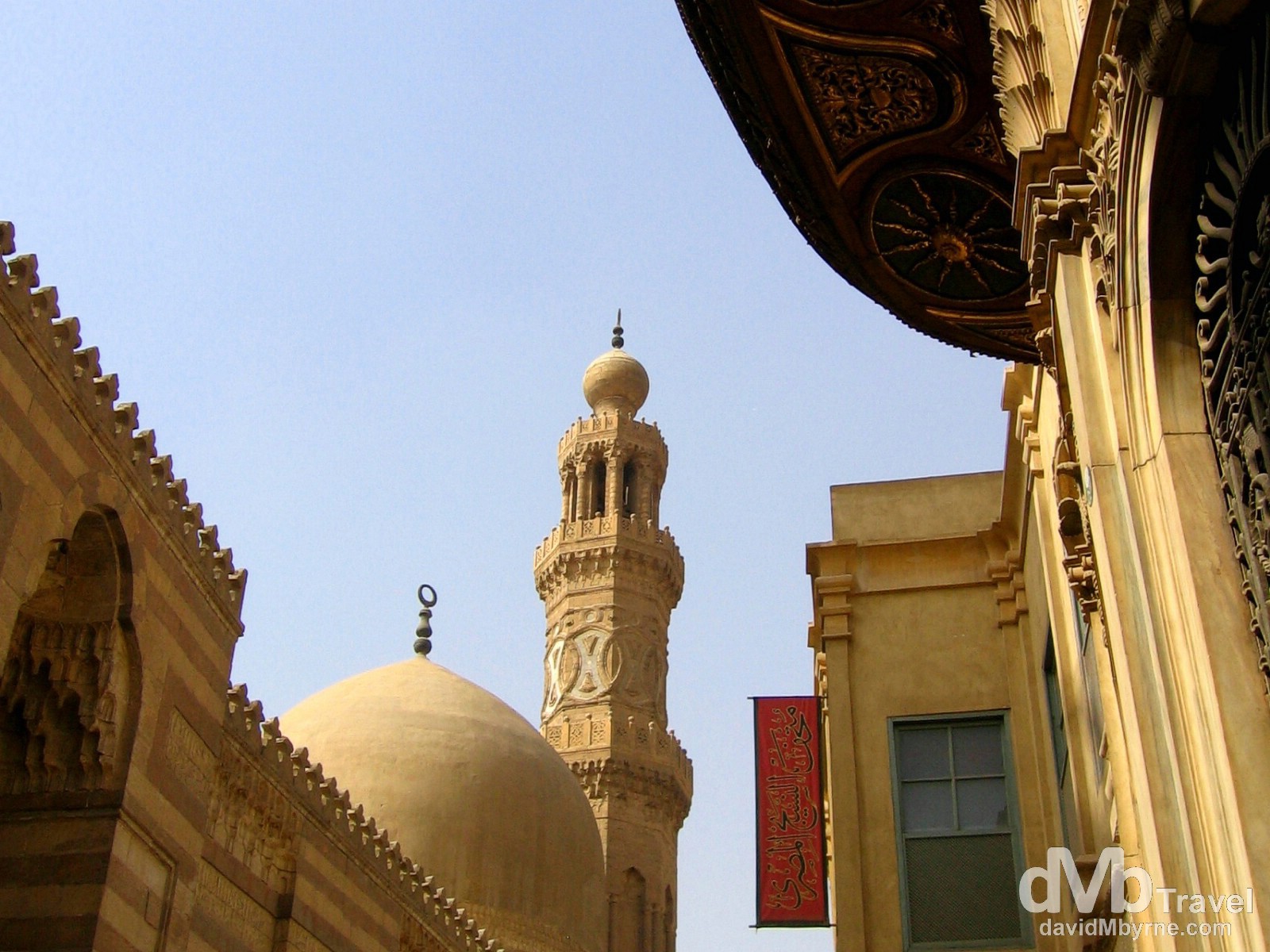
Islamic Cairo ||Islamic Cairo has many once-important medieval thoroughfares that are home to many fine Mamluk-era (13th to 16th century) mosques, madrassas (Islamic/religious schools) and caravanserais (an inn with a large courtyard that provides accommodation for caravans), some of the finest of which are seen here on Al-Muizz li-Din Allah. An earthquake in 1992 caused a lot of damage in this area, though it did lead to a great many of the mosques and monuments being gradually returned to their former glory after years of neglect, often with financial aid from organizations like the American Research Center and the World Monuments Fund. However, this means that many of Islamic Cairo’s monuments are currently closed to the public, at least officially; a baksheesh (tip) will miraculously open any door here and you can’t walk 10 steps without being offered a ‘secret look’ behind a closed door. Al-Muizz li-Din Allah, Khan Al-Khalili, Cairo, Egypt. April 14, 2008.
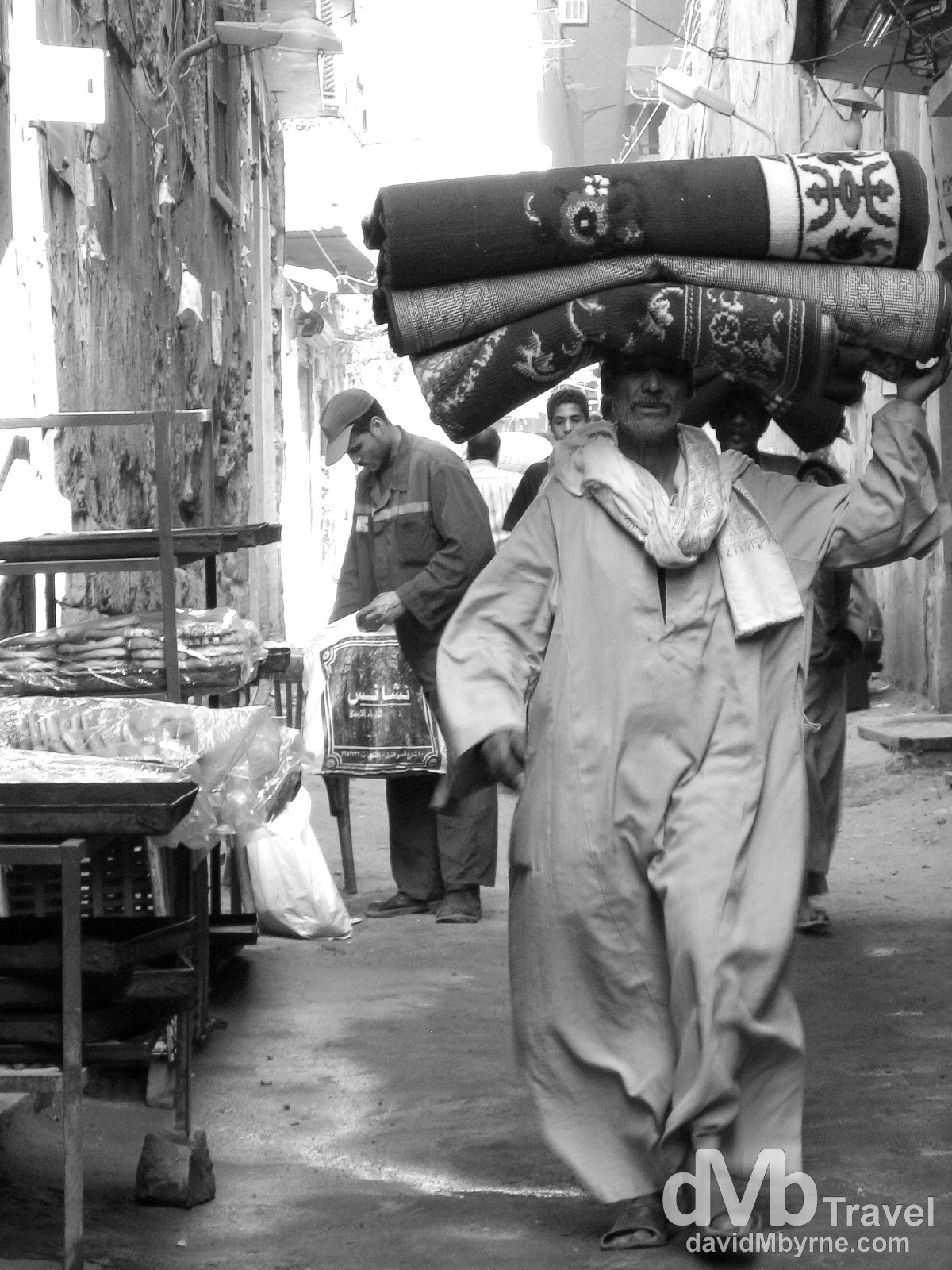
Al-Gamaliyya, Khan Al-Khalili, Islamic Cairo, Cairo, Egypt. April 14, 2008.
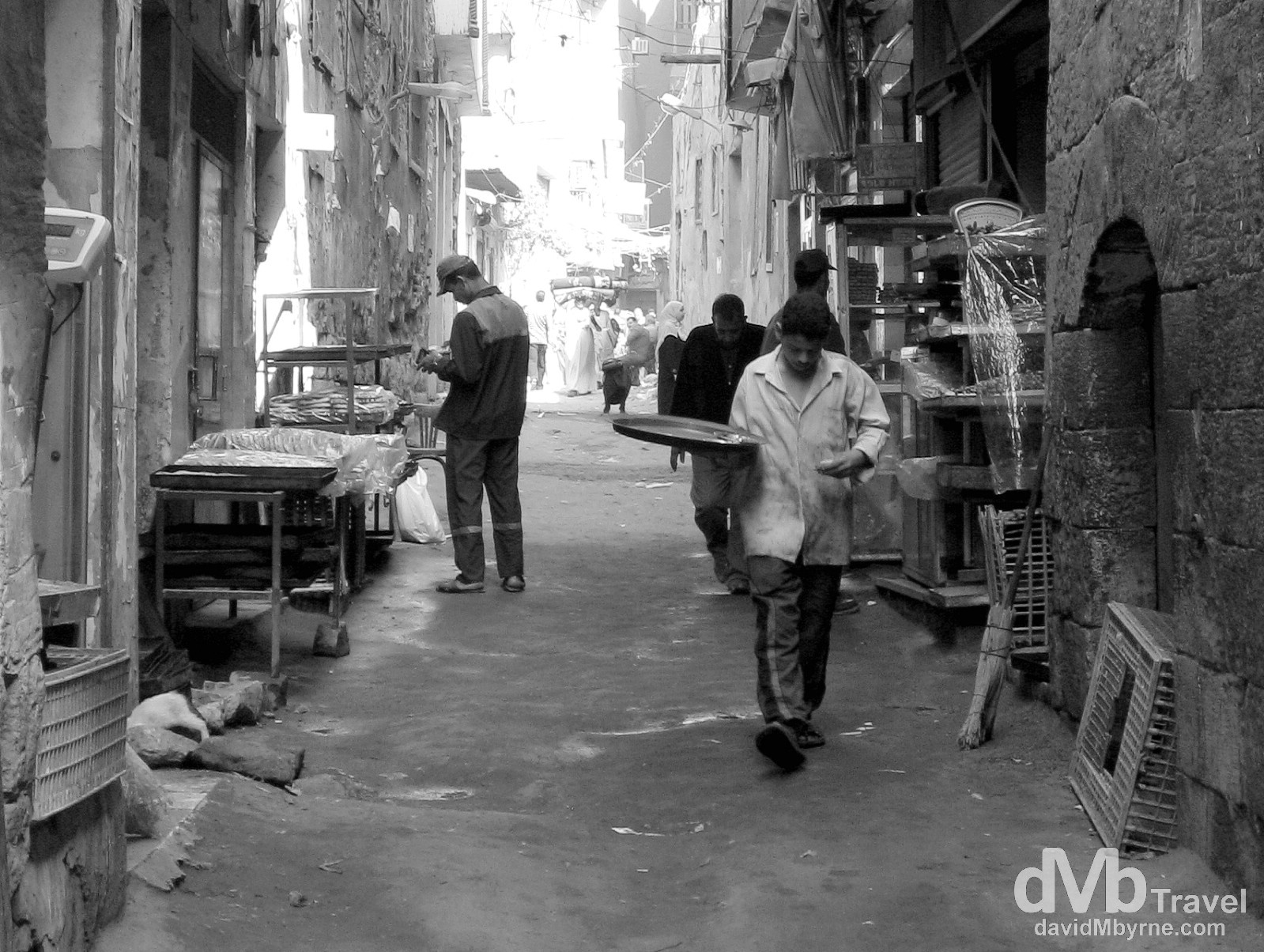
Khan al-Khalili, Islamic Cairo || In the lanes off Khan al-Khalili, the great bazaar, in the Islamic district of the city, a typically crowded, chaotic and noisy place, thronged with both locals and tourists. Spending only a few hours wandering these lanes can feel like attending a course in sales resistance and baksheesh evasion. This picture was captured in one of the many labyrinthine lanes in the Islamic district, lanes that are uneven, narrow, congested & overhung with latticed balconies. They are also slimy underfoot with goat & donkey droppings and burst water mains. Mosques, bazaars and medieval trading lanes abound with the smell of sheesha (water pipe) and frying offal wafting in the air. It all combines to make this a unique part of a unique city. Al-Gamaliyya, Khan Al-Khalili, Cairo, Egypt. April 14, 2008.
Of course we also continued to dodge the traffic and the touts on Cairo’s streets; paid a few more visits to Drinkies (we’re not, and never will be, on 1st name terms with the staff – I don’t think they like us – I suspect they might think we’re alcoholics); ate more shwarma & Egyptian pizzas in Gad, a national western-style fast food eatery; picked up our custom-made suits we were fitted for during our first visit to the city (we’ve still to make a final judgement on their quality but first impression aren’t good); haggled with taxi drivers; and spent the last two nights viewing, from our Hotel Luna room balcony, the scene below us of illegal t-shirt sellers dodging the authorities on the always busy menswear & shoe shop infested Talaat Harb street.
The Northern Cemetery || Cities of the Dead
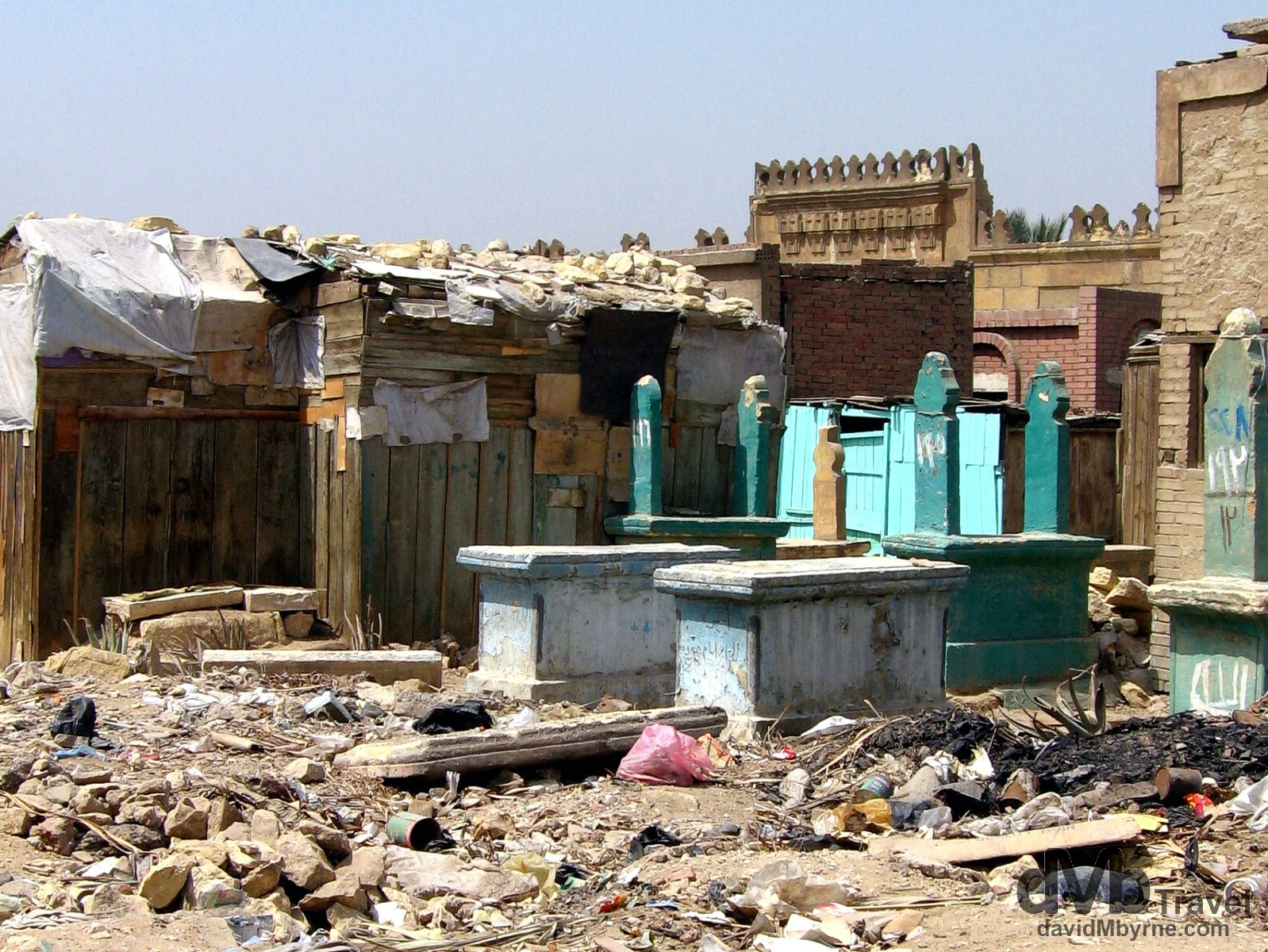
The Northern Cemetery || Cities of the Dead || Upon leaving the Saladin Citadel we haggled hard with a taxi driver to take us here, to the Northern cemetery, aka the Cities of the Dead. As we discovered 10 minutes into the taxi ride, the driver had actually no idea where we wanted to go. So we jumped ship, ended up sufficiently lost but eventually found the cemetery appearing, as it did, seemingly out of nowhere. Of course we only found the very edge of what is a huge and understandably eerie place – a large city, with squatters living all around or in the tombs, within an even bigger one. Yes, these are residences. Egyptians have a long tradition of building abodes near their ancestral graves. Even by Cairene standards these are poor but decent neighbourhoods, with shops, schools, mosques and electricity, maybe even piped water and sewers. It’s thought that at least half a million Cairenes live amid the Cities of the Dead spread across two vast cemeteries, the Northern & Southern. The population of Cairo, a city that is, as Jan Morris put it, “almost overwhelmed by its own fertility,” is today estimated at around eighteen million. That figure is swollen by a further million commuters from the Nile Delta and a thousand new migrants every day. Today one-third of Cairene households lack running water and a quarter of them have no sewers & the amount of green space per citizen has been calculated at thirteen square centimetres, not enough to cover a child’s palm. A young local boy befriended us and accompanied us as we walked swiftly through the portion of the cemetery we explored. Though these are generally not dangerous quarters, it’s best to exercise some caution when walking around – don’t flaunt money, dress modestly & be sure to be gone by night fall. The Northern Cemetery, Cairo, Egypt. April 14, 2008.
• Scamming || An Update
A few updates on the scamming. Yes, we’re still been short-changed and by and large the prices we’re paying for stuff is still arbitrary at best. But outright & obvious overcharging and arbitrary pricing is old news to us by now, almost 7 days into our Egyptian adventure. A few new approaches, if you will. A trolley boy on the (correct) train back to Cairo from Luxor simply didn’t have change after we made a purchase of two sandwiches. And neither did the taxi driver who played dumb today when we asked for our change, and this was after he had brought us nowhere near where we actually requested to go. Both got a nice, albeit unwarranted, tip. Oh, and how about the metro employee who obviously made a mistake by giving us the correct change in the first place but in doing so made sure to give us the most tattered, disheveled notes he could find, notes we’ve subsequently found hard to pass off. This included the bus driver on the bus to the pyramids who took exception to the condition of the notes we used to pay our fare and thus let us off nowhere near the entrance to the pyramids (oh, he knew where we wanted to go alright). Tattered notes – just something else to watch out for.
Saladin Citadel & Mohammed Ali Mosque
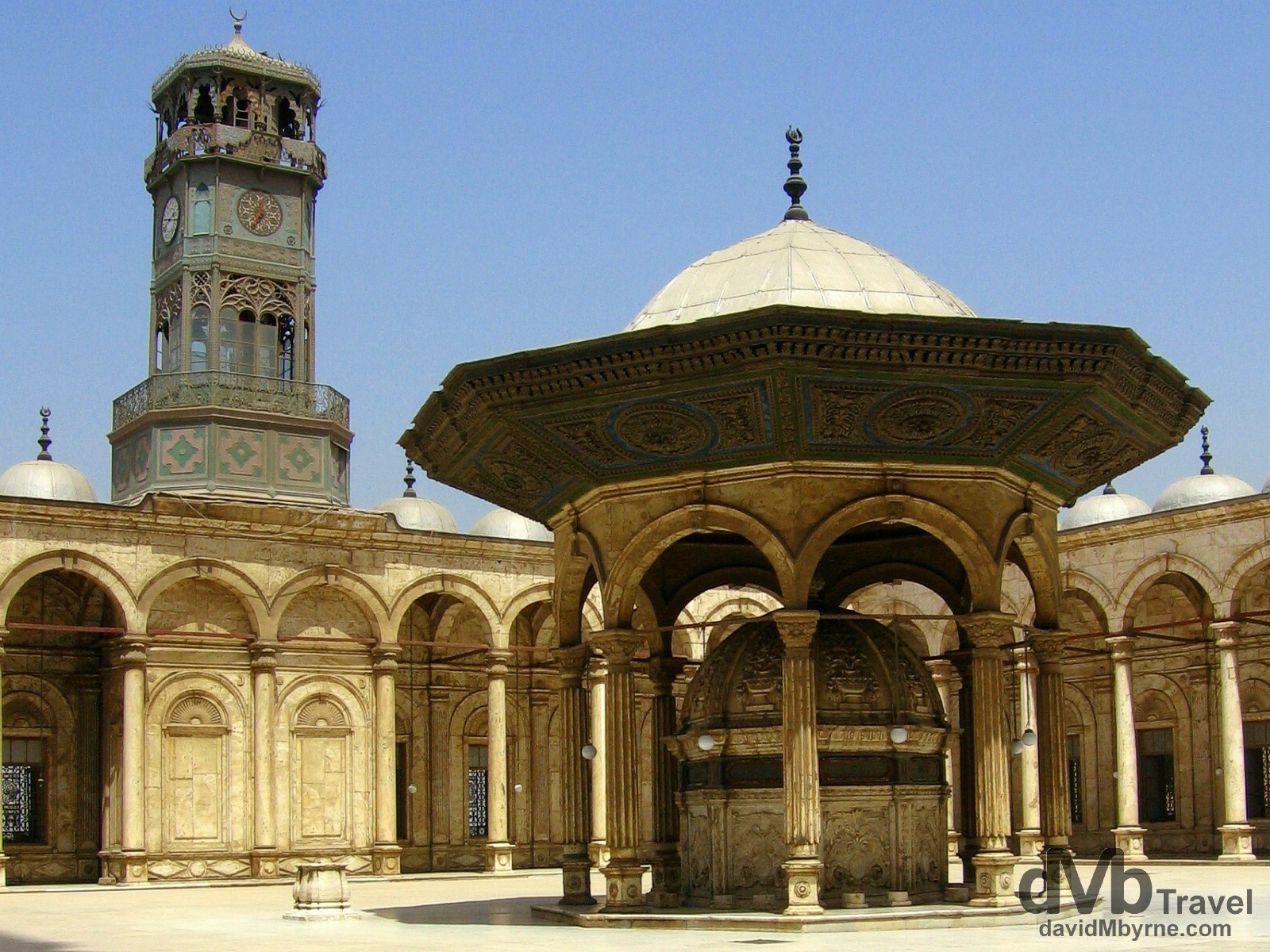
Mohammed Ali Mosque, Saladin Citadel ||The marble-heavy external courtyard of the Muhammad Ali Mosque in the Saladin Citadel, the seat of power and the residence of Egypt’s rulers for nearly 700 years – ruling power was moved in the 1860s to the newly built Abdin Palace. The citadel presents the most dramatic feature of Cairo’s skyline, a centuries-old bastion crowned by the needle-like minarets of the great Mosque of Mohammed Ali, regarded as the founder of modern Egypt – the dynasty he established ruled Egypt and Sudan until the Egyptian Revolution of 1952. The mosque itself was erected between 1824 and 1848 but the domes had to be demolished and rebuilt in the 1930s. It’s external courtyard is dominated by the two structures seen here – an ornate clock and the Turkish Baroque ablutions fountain. The clock was given by France’s King Louis Philippe (in exchange for the obelisk in the Place de la Concorde, Paris) but it never actually worked. The Mosque of Muhammad Ali, Saladin Citadel, Cairo, Egypt. April 14, 2008.
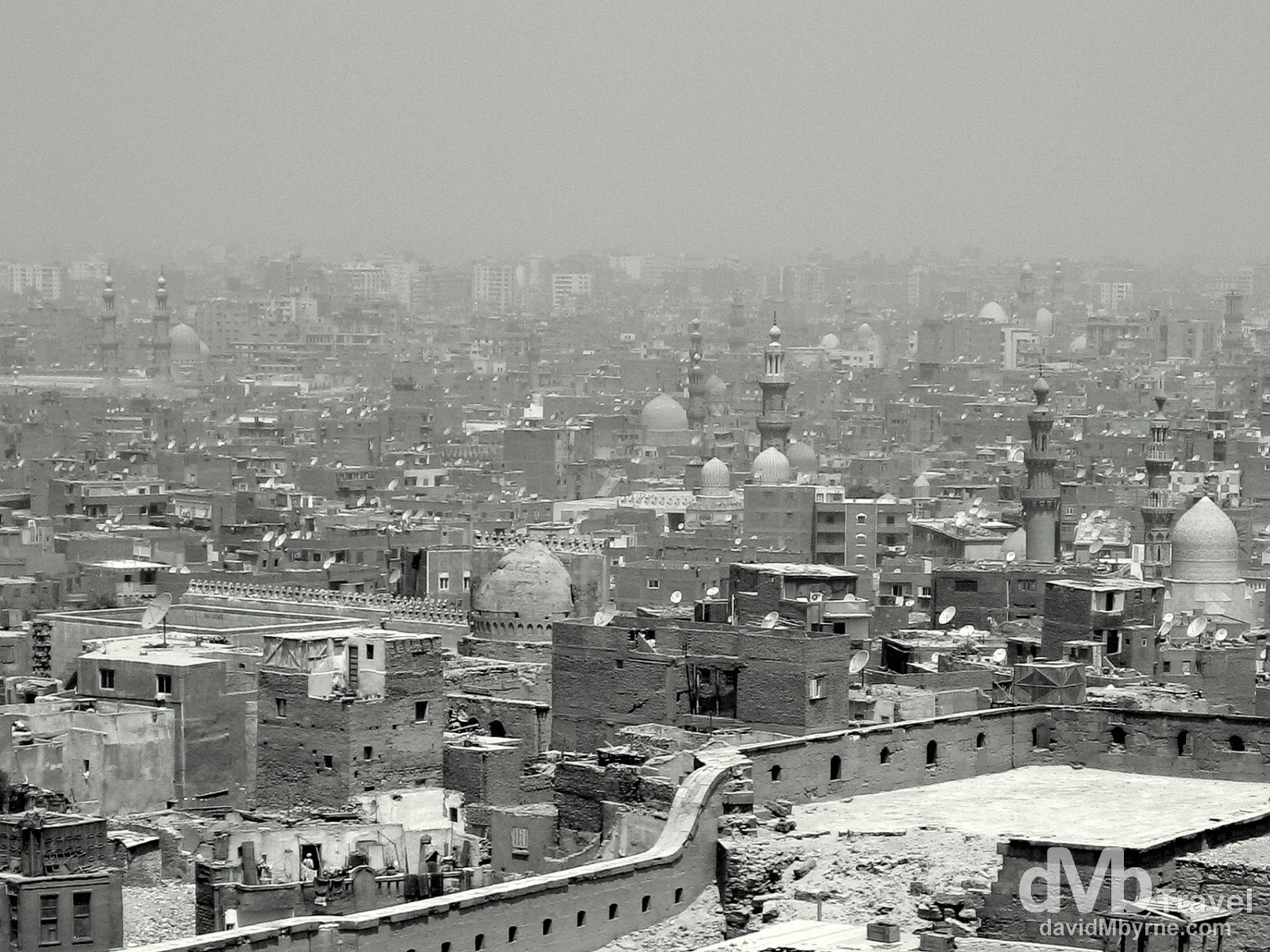
Saladin Citadel || Cairo, Egypt, as seen from the Saladin Citadel which is situated on Muqattam Hill near the center of Cairo & thus offering great views of the vast, sprawling city. This is a picture taken on the terrace outside the Citadel Police Museum, a museum of somewhat quirky exhibitions covering some of Egypt’s most sensational murders and assassinations. Very random I know, but that’s Egypt for you. Saladin Citadel, Cairo, Egypt. April 14, 2008.
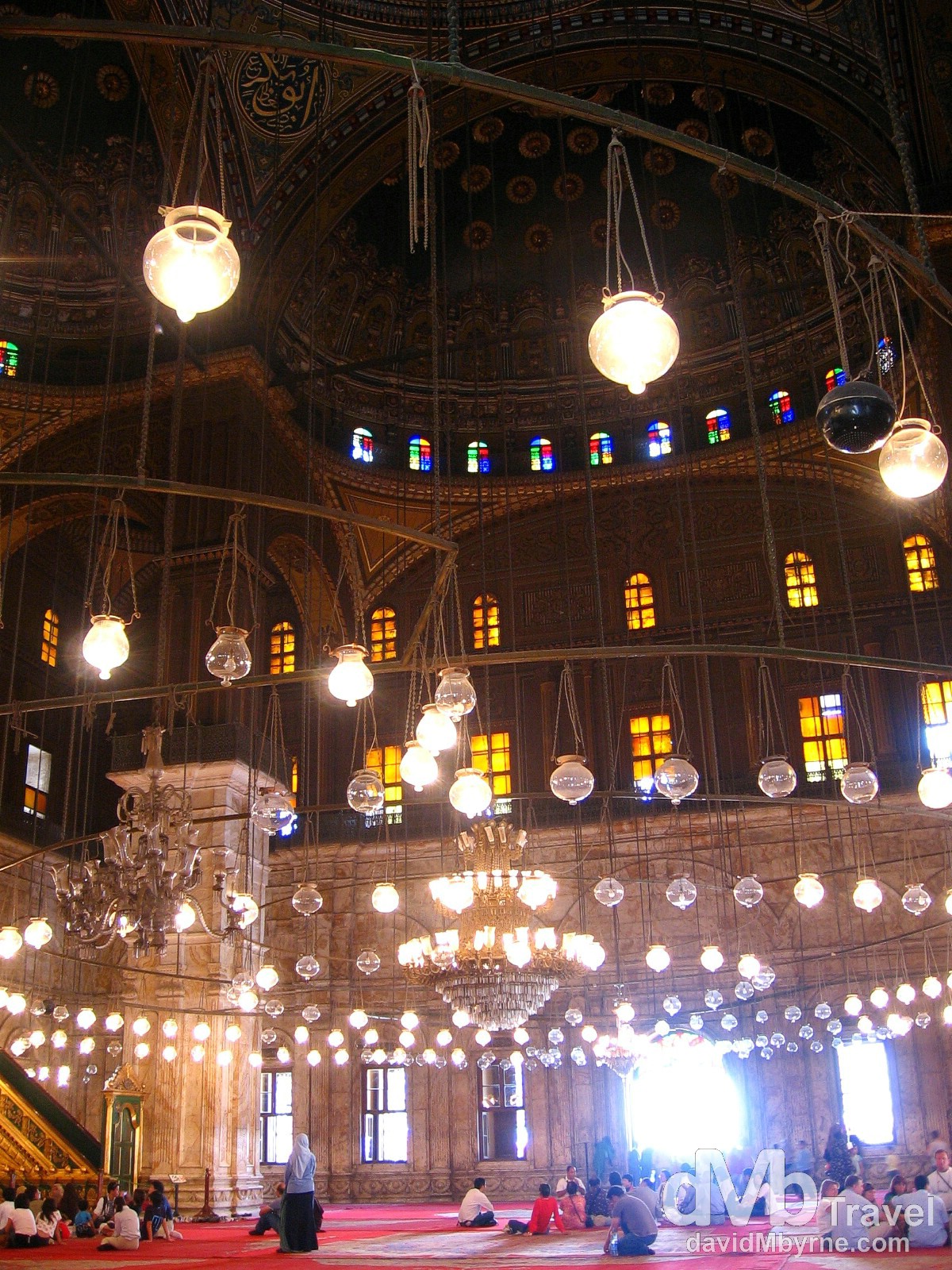
Muhammad Ali Mosque, Saladin Citadel || A bad picture of the awesome interior of the Muhammad Ali Mosque, whose lofty dome and semi-domes are decorated like a Fabergé egg. The use of space is classically Ottoman, reminiscent of the great mosques of Istanbul. A constellation of chandeliers and globe lamps illuminates Thuluth inscriptions, a gold-scalloped mihrab (a niche in the wall of a mosque that indicates the direction of Mecca) and two minbars (a pulpit in a mosque where the Imam – leader of prayer – stands to deliver sermons), one faced in alabaster, the other strangely Art Nouveau. Muhammad Ali himself is buried beneath a white marble cenotaph in here somewhere. Muhammad Ali Mosque, Saladin Citadel, Cairo, Egypt. April 14, 2008.
A few observations from the last few days.
• Riding The (Wrong Egyptian) Rails
Maybe it was the Stella’s we had. Maybe we were just too anxious to get out of Luxor. Maybe it was the fact that no one in Luxor train station seemed to know when the 11 p.m. train to Cairo, the train we had tickets for, was due to arrive. Or maybe, just maybe, it was a combination of all three. Whatever the reason we ended up hopping on the wrong train out of Luxor 2 nights ago. That caused quite a bit of consternation with the carriage attendant who did an amicable job of 1) hiding his discomfort at seeing two westerners on his train, and 2) informing us that we had to get off the train in a place called Qena, the next stop, and wait there for the train we were supposed to be on to arrive. The travel restrictions placed on foreigners travelling to and from Luxor, the ones I spoke of in my first entry from Cairo, was the obvious reason why we couldn’t just stay on the Cairo bound train we found ourselves on. We knew/suspected that, meaning we didn’t even bother to question why we couldn’t just stay where we were. The hour or so we spent in Qena station at 1 a.m. was an interesting hour an I doubt our remaining Egyptian itinerary will see us gracing such a nondescript, lawless, symbolic looking place again, even it is was only the platform of a train station.
• “Finished”
We’re both coffee drinkers so we know exactly how long ago it was that we had our last semi-decent cup of the stuff (for the record it was in Goa, India, almost 2 weeks ago). Here in Egypt you either get weak sachet coffee (called Nescafe) or the gritty, bitter Turkish variety, the latter tasting nothing like coffee as we know & love it – it’s an acquired taste neither of us has yet acquired. There are a few havens here where you can get a coffee but, and in keeping with the Egypt theme, getting a drink can prove to be a bit of work. Take for example our most recent visit, shortly after getting off the train from Luxor yesterday morning, to one such establishment, a western-style cafe complete with air-con, a glossy English menu and western prices. Pat ordered an Americano from the menu only to be told that there was no Americano coffees on offer.
“Finished,” we were told.
Finished. What does that mean, we wondered.
Pat then went to work on the poor waiter who had obviously drawn the short straw; even though we assumed, given where we worked, that he would interact with foreigners on a daily basis he was clearly petrified by having to communicate with us in any way.
“Do you have espresso?” Pat asked a few times, before finally receiving a rather nervous looking response of “yes.”
It took Pat a while but he eventually managed to inform the waiter that the coffee he was looking for was simply an espresso with boiled water, a watered down espresso. It took a few more minutes for us to be told a few more times that Americano coffees were “finished” and another few minutes after that for Pat to actually convince the by now sweating waiter to bring him an espresso & a cup of boiling water. It worked and though Pat enjoyed his DIY Americano and I enjoyed my cappuccino we’ll be sticking with tea from now on. In Egypt it’s just easier. And easier here is good. Oh so good.
– Robert Irwin, The Arabian Nightmare
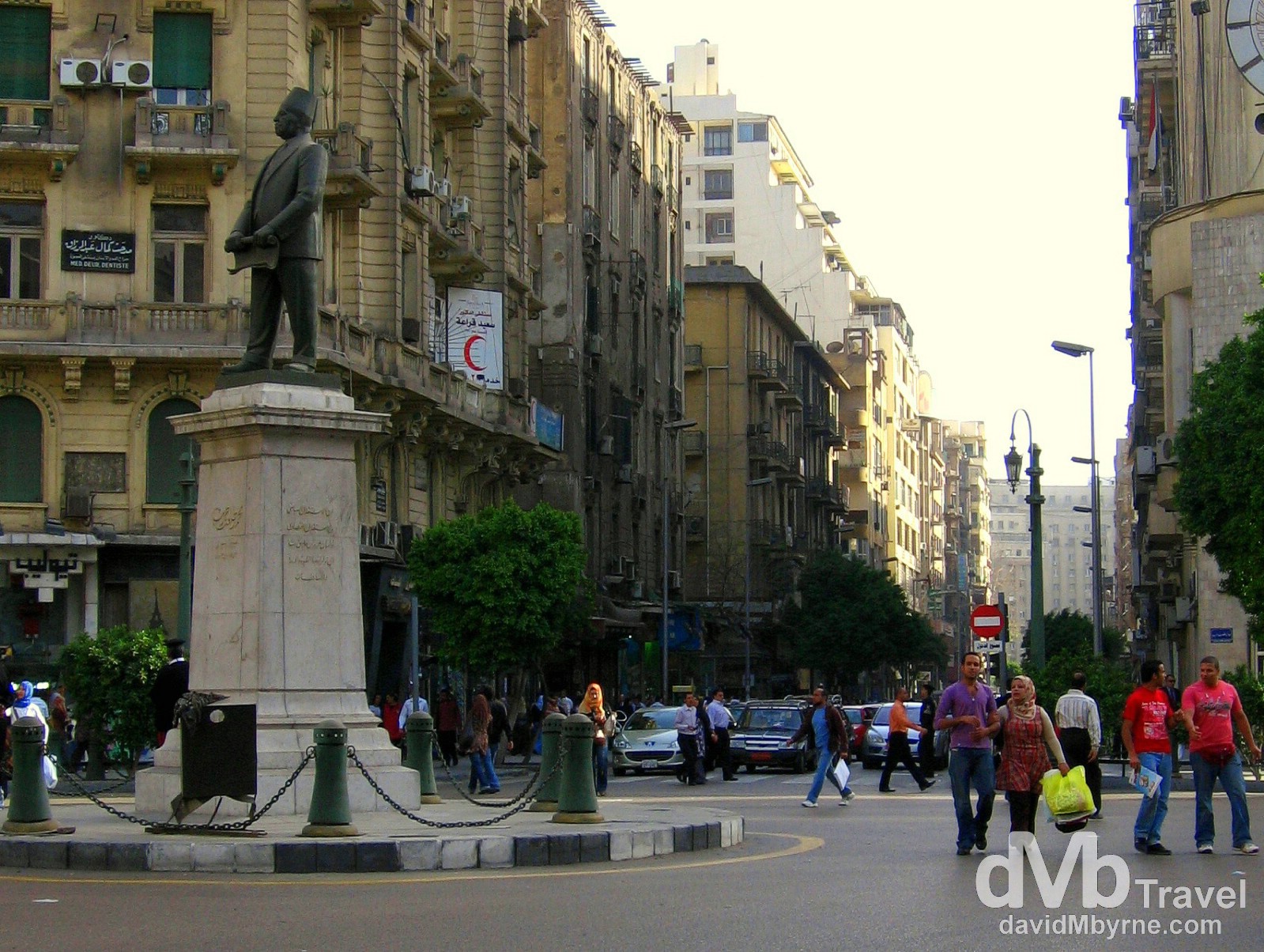
Cairo, Egypt. April 10, 2008.
• 2 firsts
We had two firsts yesterday. It was first time we rode in one of Cairo’s beat-up Peugeot taxis, one whose roof rather alarmingly dropped to meet us once the car did any kind of speed. That was something the taxi driver found hilarious. Either that or it was our reaction to the collapsing roof that he found hilarious. The other first was not getting ripped off. It was by the same taxi driver who, surprise surprise, didn’t actually take us to where we wanted to go but took us somewhere more convenient, and only for a slightly inflated fare. He was a good guy, proving that not all Egyptians are out to profit from an encounter with a westerner.
• Put them away
I was lambasted earlier today by an elderly Egyptian lady on the streets of the city for wearing shorts. Yep, it happened well away from the tourist frequented areas of the city (meaning we were lost), somewhere we walked to in search of the Northern cemetery. Our guidebook reminds those who care to read it (seemingly few of other tourists on Cairo’s streets), that…
Fair enough but I’d recommend that nice elderly lady, who is no doubt having nightmares tonight over the sight of my legs and cursing me to Allah, not to go near the Kham al-Khalili bazaar area of Islamic Cairo where she would see western girls in skimpy string-vests and shorts that would make a beach-volleyball player blush.
• Killing the Golden Goose
Unless you visit Egypt on an all-inclusive package/guided tour, spending your time in 5-Star hotels and get ferried from sight to sight in air-conditioned buses with an accompanying tour guide, then be prepared to be harassed and ripped off by most everyone you encounter. An unfair generalisation maybe but sad to say but we believe Egypt is slowly killing the Goose (its tourist industry) that lays the golden egg (its myriad and timeless attractions). Egypt is the oldest tourist destination on earth and its attractions are bigger than any opinions anyone might express and we have no doubt that people will continue to flock to its age-old draws no matter how much hassle those same people receive and may report on. But make no mistake – as an independent traveller, one who is not sheltered by the package tour/5-Star hotel/tour guide bubble, Egypt is a testing place to travel.
Outta Here, Part II
In the morning we leave the city for the second time, this time for good. By the time we do so we’ll have spent a total of 4 nights in Cairo, 4 nights that neatly sandwiched the 3 nights we spent getting to, from and in Luxor. We think 4 nights is long enough to spend here. Of course there are those who would disagree, advocating that with so much to see and do you could spend weeks and merely scratch the surface of the city. And they’d be right. Then there are those who would have a string of reasons why 4 nights here is too long, chief among them being the city’s density, pollution and maybe even the culture shock one could conceivably suffer here. None of that really bothered us. The touts on the other hand did but they, we regretfully suspect, are not only limited to Cairo or Luxor. We just feel it’s time to move on. And we’ve still quite a bit of ground to cover. We’re heading north to the Mediterranean coast and to Alexandria where we hear a ‘different’ kind of Egyptian city awaits. Different. We’ve absolutely no idea what that means. No touts maybe. Could we be that lucky?
